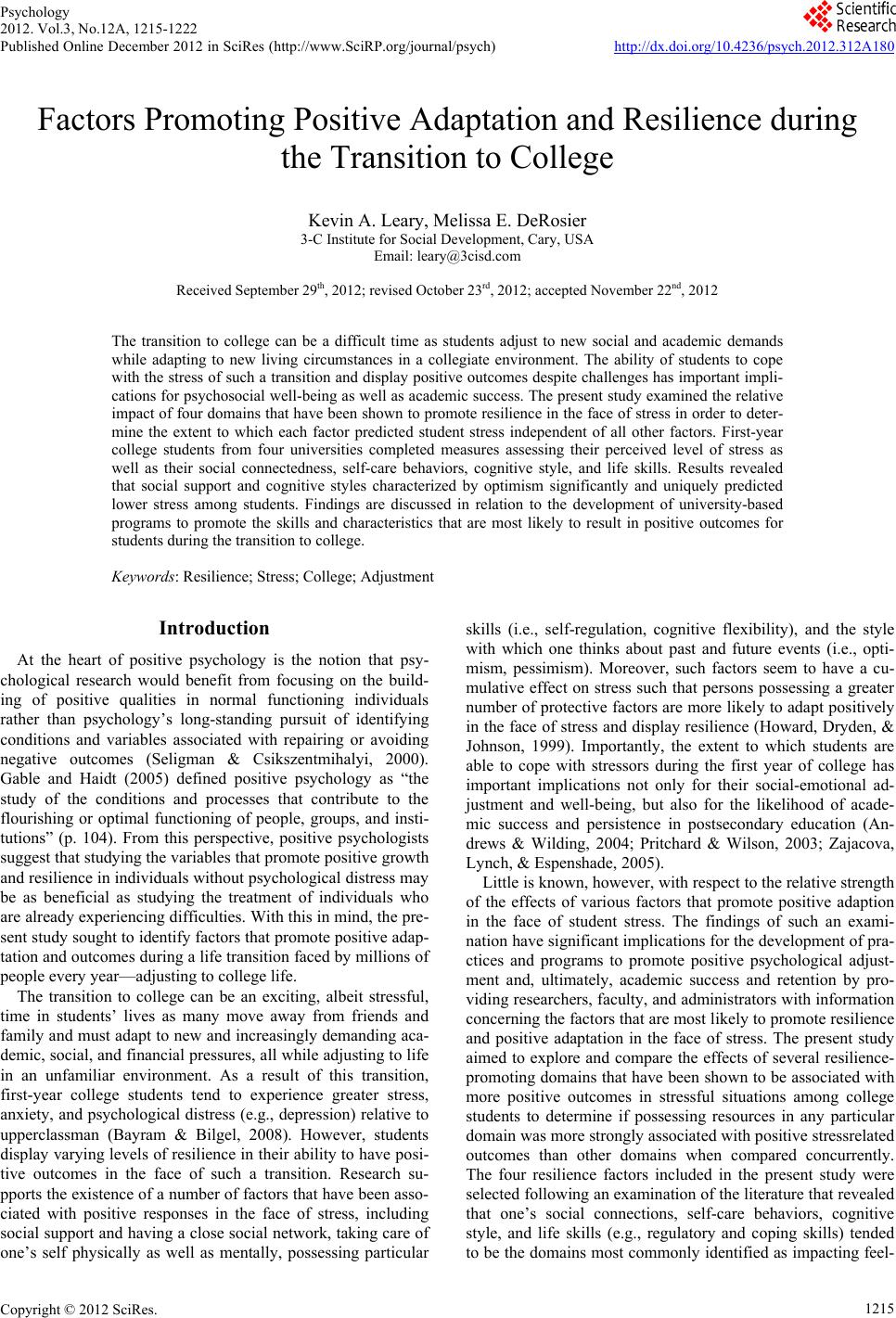 Psychology 2012. Vol.3, No.12A, 1215-1222 Published Online December 2012 in SciRes (http://www.SciRP.org/journal/psych) http://dx.doi.org/10.4236/psych.2012.312A180 Copyright © 2012 SciRes. 1215 Factors Promoting Positive Adaptation and Resilience during the Transition to College Kevin A. Leary, Melissa E. DeRosier 3-C Institute for Social Development, Cary, USA Email: leary@3cisd.com Received September 29th, 2012; revised October 23rd, 2012; accepted November 22nd, 2012 The transition to college can be a difficult time as students adjust to new social and academic demands while adapting to new living circumstances in a collegiate environment. The ability of students to cope with the stress of such a transition and display positive outcomes despite challenges has important impli- cations for psychosocial well-being as well as academic success. The present study examined the relative impact of four domains that have been shown to promote resilience in the face of stress in order to deter- mine the extent to which each factor predicted student stress independent of all other factors. First-year college students from four universities completed measures assessing their perceived level of stress as well as their social connectedness, self-care behaviors, cognitive style, and life skills. Results revealed that social support and cognitive styles characterized by optimism significantly and uniquely predicted lower stress among students. Findings are discussed in relation to the development of university-based programs to promote the skills and characteristics that are most likely to result in positive outcomes for students during the transition to college. Keywords: Resilience; Stress; College; Adjustment Introduction At the heart of positive psychology is the notion that psy- chological research would benefit from focusing on the build- ing of positive qualities in normal functioning individuals rather than psychology’s long-standing pursuit of identifying conditions and variables associated with repairing or avoiding negative outcomes (Seligman & Csikszentmihalyi, 2000). Gable and Haidt (2005) defined positive psychology as “the study of the conditions and processes that contribute to the flourishing or optimal functioning of people, groups, and insti- tutions” (p. 104). From this perspective, positive psychologists suggest that studying the variables that promote positive growth and resilience in individuals without psychological distress may be as beneficial as studying the treatment of individuals who are already experiencing difficulties. With this in mind, the pre- sent study sought to identify factors that promote positive adap- tation and outcomes during a life transition faced by millions of people every year—adjusting to college life. The transition to college can be an exciting, albeit stressful, time in students’ lives as many move away from friends and family and must adapt to new and increasingly demanding aca- demic, social, and financial pressures, all while adjusting to life in an unfamiliar environment. As a result of this transition, first-year college students tend to experience greater stress, anxiety, and psychological distress (e.g., depression) relative to upperclassman (Bayram & Bilgel, 2008). However, students display varying levels of resilience in their ability to have posi- tive outcomes in the face of such a transition. Research su- pports the existence of a number of factors that have been asso- ciated with positive responses in the face of stress, including social support and having a close social network, taking care of one’s self physically as well as mentally, possessing particular skills (i.e., self-regulation, cognitive flexibility), and the style with which one thinks about past and future events (i.e., opti- mism, pessimism). Moreover, such factors seem to have a cu- mulative effect on stress such that persons possessing a greater number of protective factors are more likely to adapt positively in the face of stress and display resilience (Howard, Dryden, & Johnson, 1999). Importantly, the extent to which students are able to cope with stressors during the first year of college has important implications not only for their social-emotional ad- justment and well-being, but also for the likelihood of acade- mic success and persistence in postsecondary education (An- drews & Wilding, 2004; Pritchard & Wilson, 2003; Zajacova, Lynch, & Espenshade, 2005). Little is known, however, with respect to the relative strength of the effects of various factors that promote positive adaption in the face of student stress. The findings of such an exami- nation have significant implications for the development of pra- ctices and programs to promote positive psychological adjust- ment and, ultimately, academic success and retention by pro- viding researchers, faculty, and administrators with information concerning the factors that are most likely to promote resilience and positive adaptation in the face of stress. The present study aimed to explore and compare the effects of several resilience- promoting domains that have been shown to be associated with more positive outcomes in stressful situations among college students to determine if possessing resources in any particular domain was more strongly associated with positive stressrelated outcomes than other domains when compared concurrently. The four resilience factors included in the present study were selected following an examination of the literature that revealed that one’s social connections, self-care behaviors, cognitive style, and life skills (e.g., regulatory and coping skills) tended to be the domains most commonly identified as impacting feel- 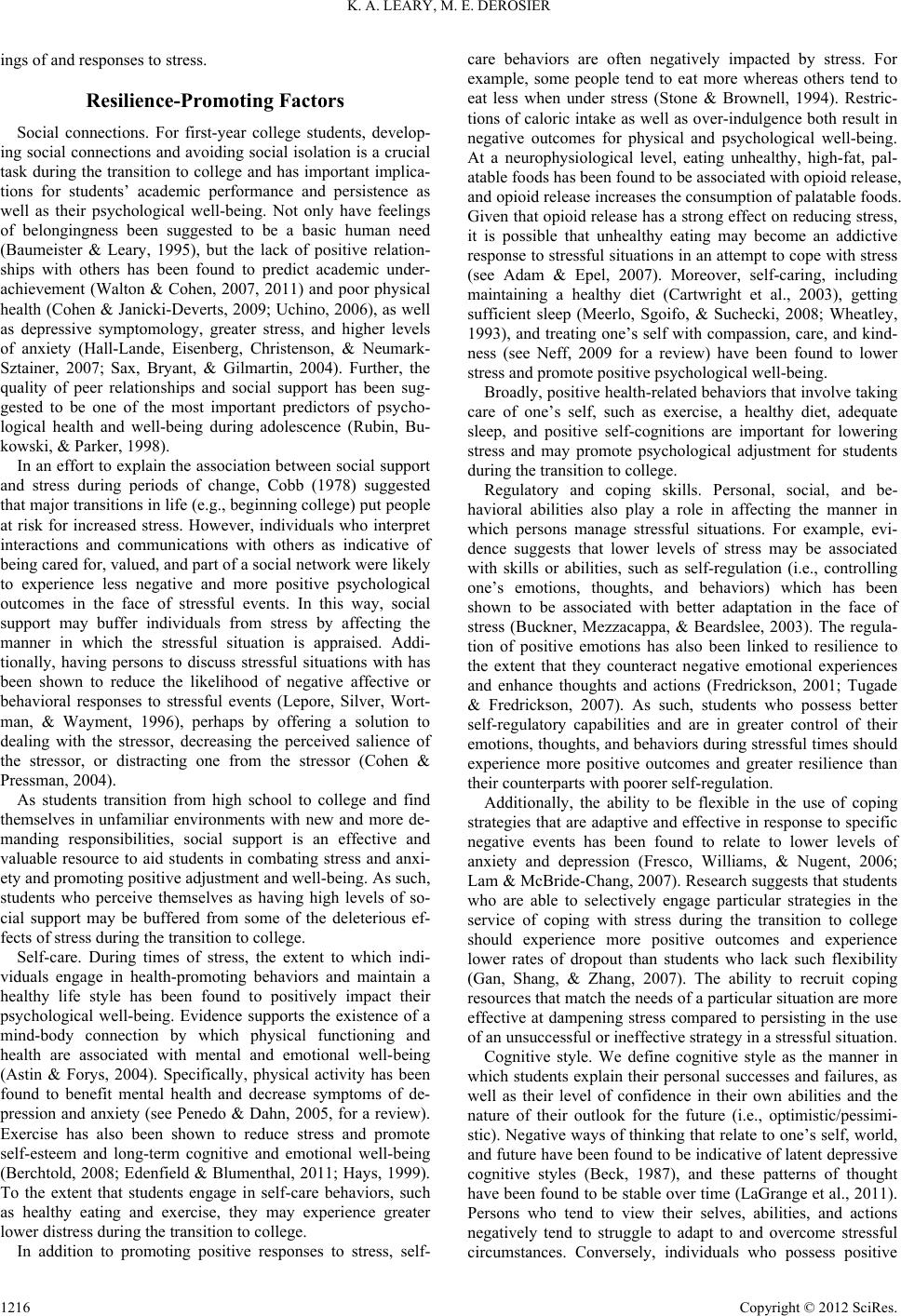 K. A. LEARY, M. E. DEROSIER ings of and responses to stress. Resilience-Promoting Factors Social connections. For first-year college students, develop- ing social connections and avoiding social isolation is a crucial task during the transition to college and has important implica- tions for students’ academic performance and persistence as well as their psychological well-being. Not only have feelings of belongingness been suggested to be a basic human need (Baumeister & Leary, 1995), but the lack of positive relation- ships with others has been found to predict academic under- achievement (Walton & Cohen, 2007, 2011) and poor physical health (Cohen & Janicki-Deverts, 2009; Uchino, 2006), as well as depressive symptomology, greater stress, and higher levels of anxiety (Hall-Lande, Eisenberg, Christenson, & Neumark- Sztainer, 2007; Sax, Bryant, & Gilmartin, 2004). Further, the quality of peer relationships and social support has been sug- gested to be one of the most important predictors of psycho- logical health and well-being during adolescence (Rubin, Bu- kowski, & Parker, 1998). In an effort to explain the association between social support and stress during periods of change, Cobb (1978) suggested that major transitions in life (e.g., beginning college) put people at risk for increased stress. However, individuals who interpret interactions and communications with others as indicative of being cared for, valued, and part of a social network were likely to experience less negative and more positive psychological outcomes in the face of stressful events. In this way, social support may buffer individuals from stress by affecting the manner in which the stressful situation is appraised. Addi- tionally, having persons to discuss stressful situations with has been shown to reduce the likelihood of negative affective or behavioral responses to stressful events (Lepore, Silver, Wort- man, & Wayment, 1996), perhaps by offering a solution to dealing with the stressor, decreasing the perceived salience of the stressor, or distracting one from the stressor (Cohen & Pressman, 2004). As students transition from high school to college and find themselves in unfamiliar environments with new and more de- manding responsibilities, social support is an effective and valuable resource to aid students in combating stress and anxi- ety and promoting positive adjustment and well-being. As such, students who perceive themselves as having high levels of so- cial support may be buffered from some of the deleterious ef- fects of stress during the transition to college. Self-care. During times of stress, the extent to which indi- viduals engage in health-promoting behaviors and maintain a healthy life style has been found to positively impact their psychological well-being. Evidence supports the existence of a mind-body connection by which physical functioning and health are associated with mental and emotional well-being (Astin & Forys, 2004). Specifically, physical activity has been found to benefit mental health and decrease symptoms of de- pression and anxiety (see Penedo & Dahn, 2005, for a review). Exercise has also been shown to reduce stress and promote self-esteem and long-term cognitive and emotional well-being (Berchtold, 2008; Edenfield & Blumenthal, 2011; Hays, 1999). To the extent that students engage in self-care behaviors, such as healthy eating and exercise, they may experience greater lower distress during the transition to college. In addition to promoting positive responses to stress, self- care behaviors are often negatively impacted by stress. For example, some people tend to eat more whereas others tend to eat less when under stress (Stone & Brownell, 1994). Restric- tions of caloric intake as well as over-indulgence both result in negative outcomes for physical and psychological well-being. At a neurophysiological level, eating unhealthy, high-fat, pal- atable foods has been found to be associated with opioid release, and opioid release increases the consumption of palatable foods. Given that opioid release has a strong effect on reducing stress, it is possible that unhealthy eating may become an addictive response to stressful situations in an attempt to cope with stress (see Adam & Epel, 2007). Moreover, self-caring, including maintaining a healthy diet (Cartwright et al., 2003), getting sufficient sleep (Meerlo, Sgoifo, & Suchecki, 2008; Wheatley, 1993), and treating one’s self with compassion, care, and kind- ness (see Neff, 2009 for a review) have been found to lower stress and promote positive psychological well-being. Broadly, positive health-related behaviors that involve taking care of one’s self, such as exercise, a healthy diet, adequate sleep, and positive self-cognitions are important for lowering stress and may promote psychological adjustment for students during the transition to college. Regulatory and coping skills. Personal, social, and be- havioral abilities also play a role in affecting the manner in which persons manage stressful situations. For example, evi- dence suggests that lower levels of stress may be associated with skills or abilities, such as self-regulation (i.e., controlling one’s emotions, thoughts, and behaviors) which has been shown to be associated with better adaptation in the face of stress (Buckner, Mezzacappa, & Beardslee, 2003). The regula- tion of positive emotions has also been linked to resilience to the extent that they counteract negative emotional experiences and enhance thoughts and actions (Fredrickson, 2001; Tugade & Fredrickson, 2007). As such, students who possess better self-regulatory capabilities and are in greater control of their emotions, thoughts, and behaviors during stressful times should experience more positive outcomes and greater resilience than their counterparts with poorer self-regulation. Additionally, the ability to be flexible in the use of coping strategies that are adaptive and effective in response to specific negative events has been found to relate to lower levels of anxiety and depression (Fresco, Williams, & Nugent, 2006; Lam & McBride-Chang, 2007). Research suggests that students who are able to selectively engage particular strategies in the service of coping with stress during the transition to college should experience more positive outcomes and experience lower rates of dropout than students who lack such flexibility (Gan, Shang, & Zhang, 2007). The ability to recruit coping resources that match the needs of a particular situation are more effective at dampening stress compared to persisting in the use of an unsuccessful or ineffective strategy in a stressful situation. Cognitive style. We define cognitive style as the manner in which students explain their personal successes and failures, as well as their level of confidence in their own abilities and the nature of their outlook for the future (i.e., optimistic/pessimi- stic). Negative ways of thinking that relate to one’s self, world, and future have been found to be indicative of latent depressive cognitive styles (Beck, 1987), and these patterns of thought have been found to be stable over time (LaGrange et al., 2011). Persons who tend to view their selves, abilities, and actions negatively tend to struggle to adapt to and overcome stressful circumstances. Conversely, individuals who possess positive Copyright © 2012 SciRes. 1216 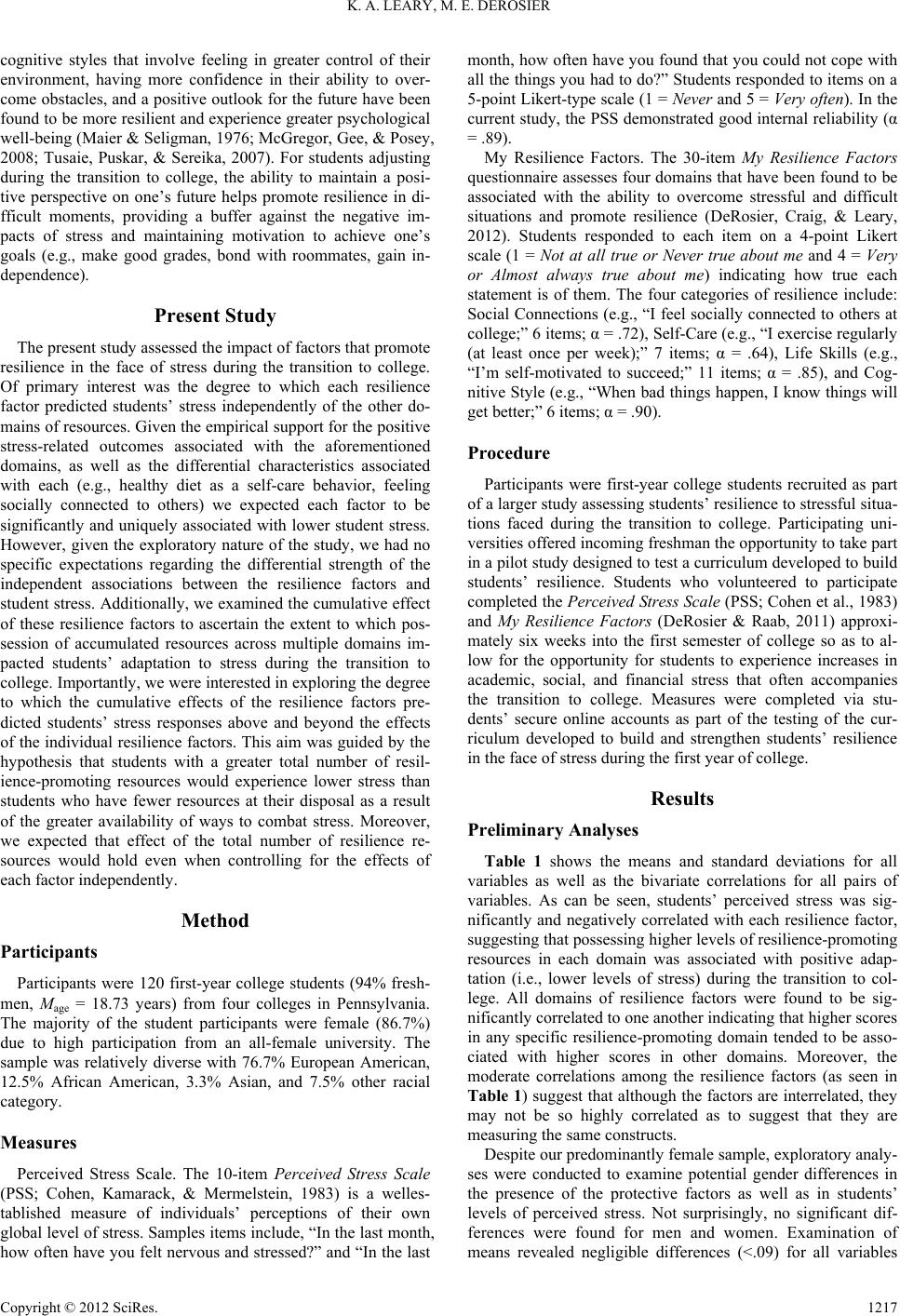 K. A. LEARY, M. E. DEROSIER cognitive styles that involve feeling in greater control of their environment, having more confidence in their ability to over- come obstacles, and a positive outlook for the future have been found to be more resilient and experience greater psychological well-being (Maier & Seligman, 1976; McGregor, Gee, & Posey, 2008; Tusaie, Puskar, & Sereika, 2007). For students adjusting during the transition to college, the ability to maintain a posi- tive perspective on one’s future helps promote resilience in di- fficult moments, providing a buffer against the negative im- pacts of stress and maintaining motivation to achieve one’s goals (e.g., make good grades, bond with roommates, gain in- dependence). Present Study The present study assessed the impact of factors that promote resilience in the face of stress during the transition to college. Of primary interest was the degree to which each resilience factor predicted students’ stress independently of the other do- mains of resources. Given the empirical support for the positive stress-related outcomes associated with the aforementioned domains, as well as the differential characteristics associated with each (e.g., healthy diet as a self-care behavior, feeling socially connected to others) we expected each factor to be significantly and uniquely associated with lower student stress. However, given the exploratory nature of the study, we had no specific expectations regarding the differential strength of the independent associations between the resilience factors and student stress. Additionally, we examined the cumulative effect of these resilience factors to ascertain the extent to which pos- session of accumulated resources across multiple domains im- pacted students’ adaptation to stress during the transition to college. Importantly, we were interested in exploring the degree to which the cumulative effects of the resilience factors pre- dicted students’ stress responses above and beyond the effects of the individual resilience factors. This aim was guided by the hypothesis that students with a greater total number of resil- ience-promoting resources would experience lower stress than students who have fewer resources at their disposal as a result of the greater availability of ways to combat stress. Moreover, we expected that effect of the total number of resilience re- sources would hold even when controlling for the effects of each factor independently. Method Participants Participants were 120 first-year college students (94% fresh- men, Mage = 18.73 years) from four colleges in Pennsylvania. The majority of the student participants were female (86.7%) due to high participation from an all-female university. The sample was relatively diverse with 76.7% European American, 12.5% African American, 3.3% Asian, and 7.5% other racial category. Measures Perceived Stress Scale. The 10-item Perceived Stress Scale (PSS; Cohen, Kamarack, & Mermelstein, 1983) is a welles- tablished measure of individuals’ perceptions of their own global level of stress. Samples items include, “In the last month, how often have you felt nervous and stressed?” and “In the last month, how often have you found that you could not cope with all the things you had to do?” Students responded to items on a 5-point Likert-type scale (1 = Never and 5 = Very often). In the current study, the PSS demonstrated good internal reliability (α = .89). My Resilience Factors. The 30-item My Resilience Factors questionnaire assesses four domains that have been found to be associated with the ability to overcome stressful and difficult situations and promote resilience (DeRosier, Craig, & Leary, 2012). Students responded to each item on a 4-point Likert scale (1 = Not at all true or Never true about me and 4 = Very or Almost always true about me) indicating how true each statement is of them. The four categories of resilience include: Social Connections (e.g., “I feel socially connected to others at college;” 6 items; α = .72), Self-Care (e.g., “I exercise regularly (at least once per week);” 7 items; α = .64), Life Skills (e.g., “I’m self-motivated to succeed;” 11 items; α = .85), and Cog- nitive Style (e.g., “When bad things happen, I know things will get better;” 6 items; α = .90). Procedure Participants were first-year college students recruited as part of a larger study assessing students’ resilience to stressful situa- tions faced during the transition to college. Participating uni- versities offered incoming freshman the opportunity to take part in a pilot study designed to test a curriculum developed to build students’ resilience. Students who volunteered to participate completed the Perceived Stress Scale (PSS; Cohen et al., 1983) and My Resilience Factors (DeRosier & Raab, 2011) approxi- mately six weeks into the first semester of college so as to al- low for the opportunity for students to experience increases in academic, social, and financial stress that often accompanies the transition to college. Measures were completed via stu- dents’ secure online accounts as part of the testing of the cur- riculum developed to build and strengthen students’ resilience in the face of stress during the first year of college. Results Preliminary Analyses Table 1 shows the means and standard deviations for all variables as well as the bivariate correlations for all pairs of variables. As can be seen, students’ perceived stress was sig- nificantly and negatively correlated with each resilience factor, suggesting that possessing higher levels of resilience-promoting resources in each domain was associated with positive adap- tation (i.e., lower levels of stress) during the transition to col- lege. All domains of resilience factors were found to be sig- nificantly correlated to one another indicating that higher scores in any specific resilience-promoting domain tended to be asso- ciated with higher scores in other domains. Moreover, the moderate correlations among the resilience factors (as seen in Table 1) suggest that although the factors are interrelated, they may not be so highly correlated as to suggest that they are measuring the same constructs. Despite our predominantly female sample, exploratory analy- ses were conducted to examine potential gender differences in the presence of the protective factors as well as in students’ levels of perceived stress. Not surprisingly, no significant dif- ferences were found for men and women. Examination of means revealed negligible differences (<.09) for all variables Copyright © 2012 SciRes. 1217 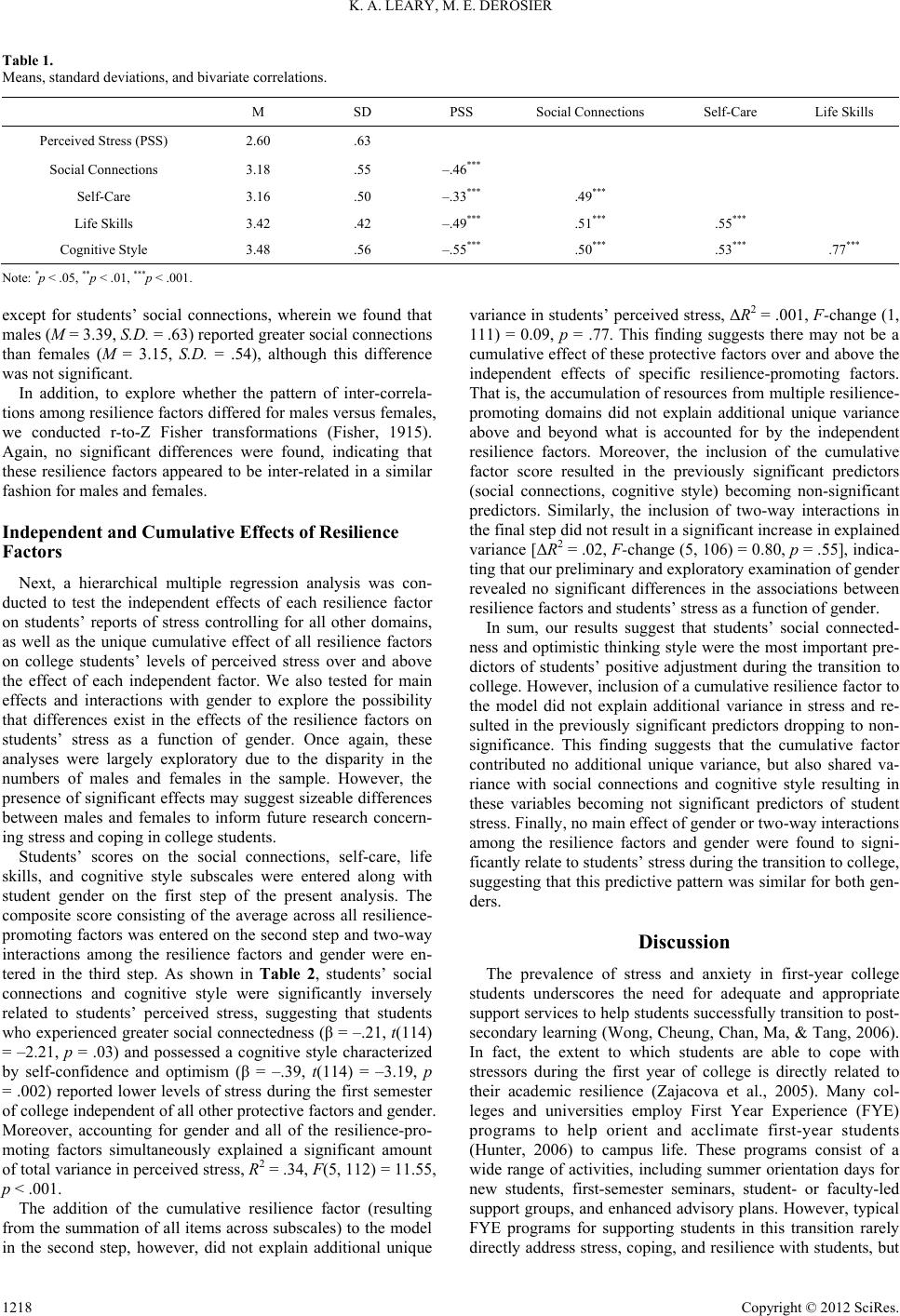 K. A. LEARY, M. E. DEROSIER Copyright © 2012 SciRes. 1218 Table 1. Means, standard deviations, and bivariate correlations. M SD PSS Social Connections Self-Care Life Skills Perceived Stress (PSS) 2.60 .63 Social Connections 3.18 .55 –.46*** Self-Care 3.16 .50 –.33*** .49*** Life Skills 3.42 .42 –.49*** .51*** .55*** Cognitive Style 3.48 .56 –.55*** .50*** .53*** .77*** Note: *p < .05, **p < .01, ***p < .001. except for students’ social connections, wherein we found that males (M = 3.39, S.D. = .63) reported greater social connections than females (M = 3.15, S.D. = .54), although this difference was not significant. In addition, to explore whether the pattern of inter-correla- tions among resilience factors differed for males versus females, we conducted r-to-Z Fisher transformations (Fisher, 1915). Again, no significant differences were found, indicating that these resilience factors appeared to be inter-related in a similar fashion for males and females. Independent and Cumulative Effects of Resilience Factors Next, a hierarchical multiple regression analysis was con- ducted to test the independent effects of each resilience factor on students’ reports of stress controlling for all other domains, as well as the unique cumulative effect of all resilience factors on college students’ levels of perceived stress over and above the effect of each independent factor. We also tested for main effects and interactions with gender to explore the possibility that differences exist in the effects of the resilience factors on students’ stress as a function of gender. Once again, these analyses were largely exploratory due to the disparity in the numbers of males and females in the sample. However, the presence of significant effects may suggest sizeable differences between males and females to inform future research concern- ing stress and coping in college students. Students’ scores on the social connections, self-care, life skills, and cognitive style subscales were entered along with student gender on the first step of the present analysis. The composite score consisting of the average across all resilience- promoting factors was entered on the second step and two-way interactions among the resilience factors and gender were en- tered in the third step. As shown in Table 2, students’ social connections and cognitive style were significantly inversely related to students’ perceived stress, suggesting that students who experienced greater social connectedness (β = –.21, t(114) = –2.21, p = .03) and possessed a cognitive style characterized by self-confidence and optimism (β = –.39, t(114) = –3.19, p = .002) reported lower levels of stress during the first semester of college independent of all other protective factors and gender. Moreover, accounting for gender and all of the resilience-pro- moting factors simultaneously explained a significant amount of total variance in perceived stress, R2 = .34, F(5, 112) = 11.55, p < .001. The addition of the cumulative resilience factor (resulting from the summation of all items across subscales) to the model in the second step, however, did not explain additional unique variance in students’ perceived stress, ΔR2 = .001, F-change (1, 111) = 0.09, p = .77. This finding suggests there may not be a cumulative effect of these protective factors over and above the independent effects of specific resilience-promoting factors. That is, the accumulation of resources from multiple resilience- promoting domains did not explain additional unique variance above and beyond what is accounted for by the independent resilience factors. Moreover, the inclusion of the cumulative factor score resulted in the previously significant predictors (social connections, cognitive style) becoming non-significant predictors. Similarly, the inclusion of two-way interactions in the final step did not result in a significant increase in explained variance [ΔR2 = .02, F-change (5, 106) = 0.80, p = .55], indica- ting that our preliminary and exploratory examination of gender revealed no significant differences in the associations between resilience factors and students’ stress as a function of gender. In sum, our results suggest that students’ social connected- ness and optimistic thinking style were the most important pre- dictors of students’ positive adjustment during the transition to college. However, inclusion of a cumulative resilience factor to the model did not explain additional variance in stress and re- sulted in the previously significant predictors dropping to non- significance. This finding suggests that the cumulative factor contributed no additional unique variance, but also shared va- riance with social connections and cognitive style resulting in these variables becoming not significant predictors of student stress. Finally, no main effect of gender or two-way interactions among the resilience factors and gender were found to signi- ficantly relate to students’ stress during the transition to college, suggesting that this predictive pattern was similar for both gen- ders. Discussion The prevalence of stress and anxiety in first-year college students underscores the need for adequate and appropriate support services to help students successfully transition to post- secondary learning (Wong, Cheung, Chan, Ma, & Tang, 2006). In fact, the extent to which students are able to cope with stressors during the first year of college is directly related to their academic resilience (Zajacova et al., 2005). Many col- leges and universities employ First Year Experience (FYE) programs to help orient and acclimate first-year students (Hunter, 2006) to campus life. These programs consist of a wide range of activities, including summer orientation days for new students, first-semester seminars, student- or faculty-led support groups, and enhanced advisory plans. However, typical FYE programs for supporting students in this transition rarely directly address stress, coping, and resilience with students, but 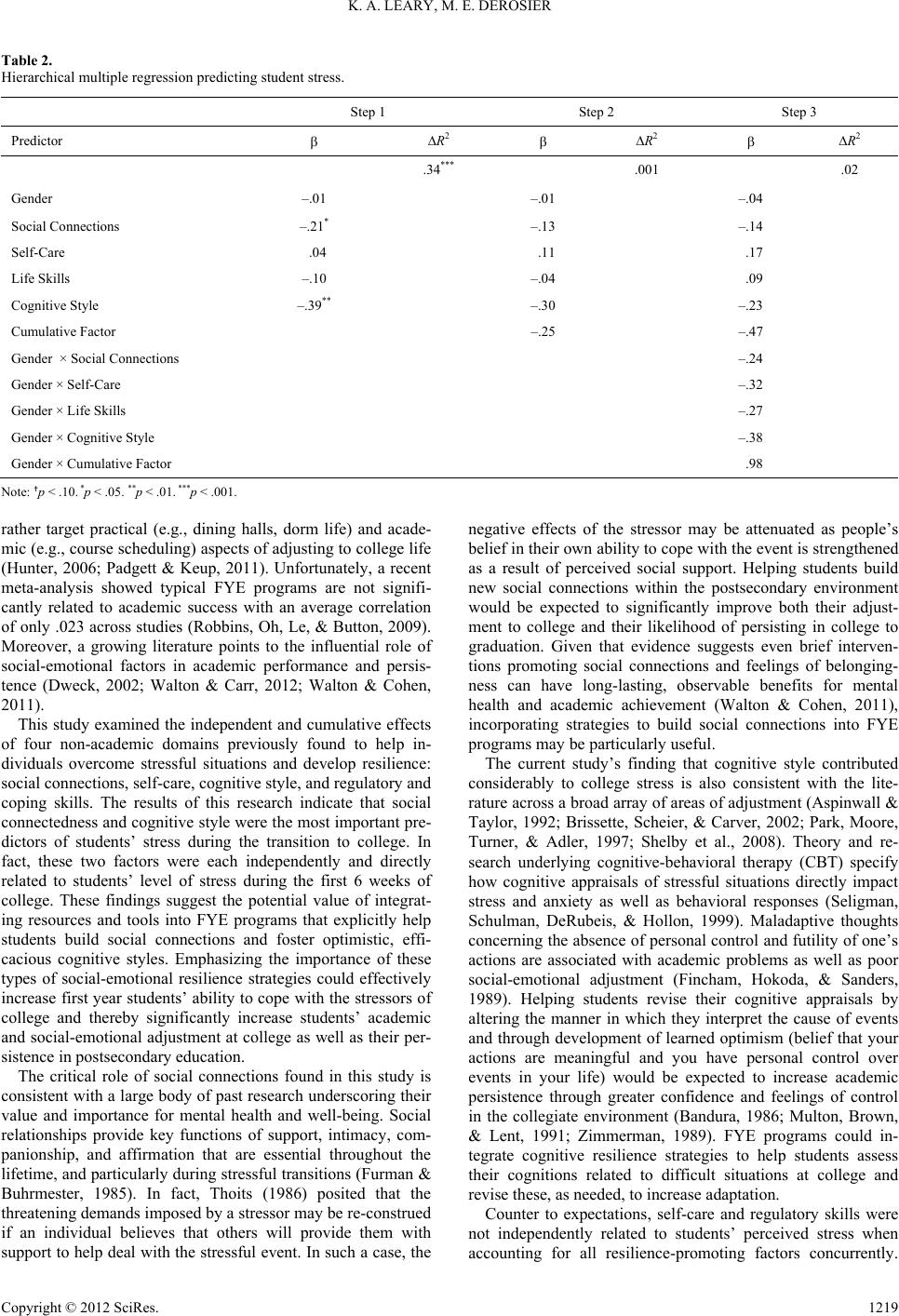 K. A. LEARY, M. E. DEROSIER Table 2. Hierarchical multiple regression predicting student stress. Step 1 Step 2 Step 3 Predictor ∆R2 ∆R2 ∆R2 .34*** .001 .02 Gender –.01 –.01 –.04 Social Connections –.21* –.13 –.14 Self-Care –.04 –.11 –.17 Life Skills –.10 –.04 –.09 Cognitive Style –.39** –.30 –.23 Cumulative Factor –.25 –.47 Gender × Social Connections –.24 Gender × Self-Care –.32 Gender × Life Skills –.27 Gender × Cognitive Style –.38 Gender × Cumulative Factor –.98 Note: p < .10. *p < .05. **p < .01. ***p < .001. rather target practical (e.g., dining halls, dorm life) and acade- mic (e.g., course scheduling) aspects of adjusting to college life (Hunter, 2006; Padgett & Keup, 2011). Unfortunately, a recent meta-analysis showed typical FYE programs are not signifi- cantly related to academic success with an average correlation of only .023 across studies (Robbins, Oh, Le, & Button, 2009). Moreover, a growing literature points to the influential role of social-emotional factors in academic performance and persis- tence (Dweck, 2002; Walton & Carr, 2012; Walton & Cohen, 2011). This study examined the independent and cumulative effects of four non-academic domains previously found to help in- dividuals overcome stressful situations and develop resilience: social connections, self-care, cognitive style, and regulatory and coping skills. The results of this research indicate that social connectedness and cognitive style were the most important pre- dictors of students’ stress during the transition to college. In fact, these two factors were each independently and directly related to students’ level of stress during the first 6 weeks of college. These findings suggest the potential value of integrat- ing resources and tools into FYE programs that explicitly help students build social connections and foster optimistic, effi- cacious cognitive styles. Emphasizing the importance of these types of social-emotional resilience strategies could effectively increase first year students’ ability to cope with the stressors of college and thereby significantly increase students’ academic and social-emotional adjustment at college as well as their per- sistence in postsecondary education. The critical role of social connections found in this study is consistent with a large body of past research underscoring their value and importance for mental health and well-being. Social relationships provide key functions of support, intimacy, com- panionship, and affirmation that are essential throughout the lifetime, and particularly during stressful transitions (Furman & Buhrmester, 1985). In fact, Thoits (1986) posited that the threatening demands imposed by a stressor may be re-construed if an individual believes that others will provide them with support to help deal with the stressful event. In such a case, the negative effects of the stressor may be attenuated as people’s belief in their own ability to cope with the event is strengthened as a result of perceived social support. Helping students build new social connections within the postsecondary environment would be expected to significantly improve both their adjust- ment to college and their likelihood of persisting in college to graduation. Given that evidence suggests even brief interven- tions promoting social connections and feelings of belonging- ness can have long-lasting, observable benefits for mental health and academic achievement (Walton & Cohen, 2011), incorporating strategies to build social connections into FYE programs may be particularly useful. The current study’s finding that cognitive style contributed considerably to college stress is also consistent with the lite- rature across a broad array of areas of adjustment (Aspinwall & Taylor, 1992; Brissette, Scheier, & Carver, 2002; Park, Moore, Turner, & Adler, 1997; Shelby et al., 2008). Theory and re- search underlying cognitive-behavioral therapy (CBT) specify how cognitive appraisals of stressful situations directly impact stress and anxiety as well as behavioral responses (Seligman, Schulman, DeRubeis, & Hollon, 1999). Maladaptive thoughts concerning the absence of personal control and futility of one’s actions are associated with academic problems as well as poor social-emotional adjustment (Fincham, Hokoda, & Sanders, 1989). Helping students revise their cognitive appraisals by altering the manner in which they interpret the cause of events and through development of learned optimism (belief that your actions are meaningful and you have personal control over events in your life) would be expected to increase academic persistence through greater confidence and feelings of control in the collegiate environment (Bandura, 1986; Multon, Brown, & Lent, 1991; Zimmerman, 1989). FYE programs could in- tegrate cognitive resilience strategies to help students assess their cognitions related to difficult situations at college and revise these, as needed, to increase adaptation. Counter to expectations, self-care and regulatory skills were not independently related to students’ perceived stress when accounting for all resilience-promoting factors concurrently. Copyright © 2012 SciRes. 1219 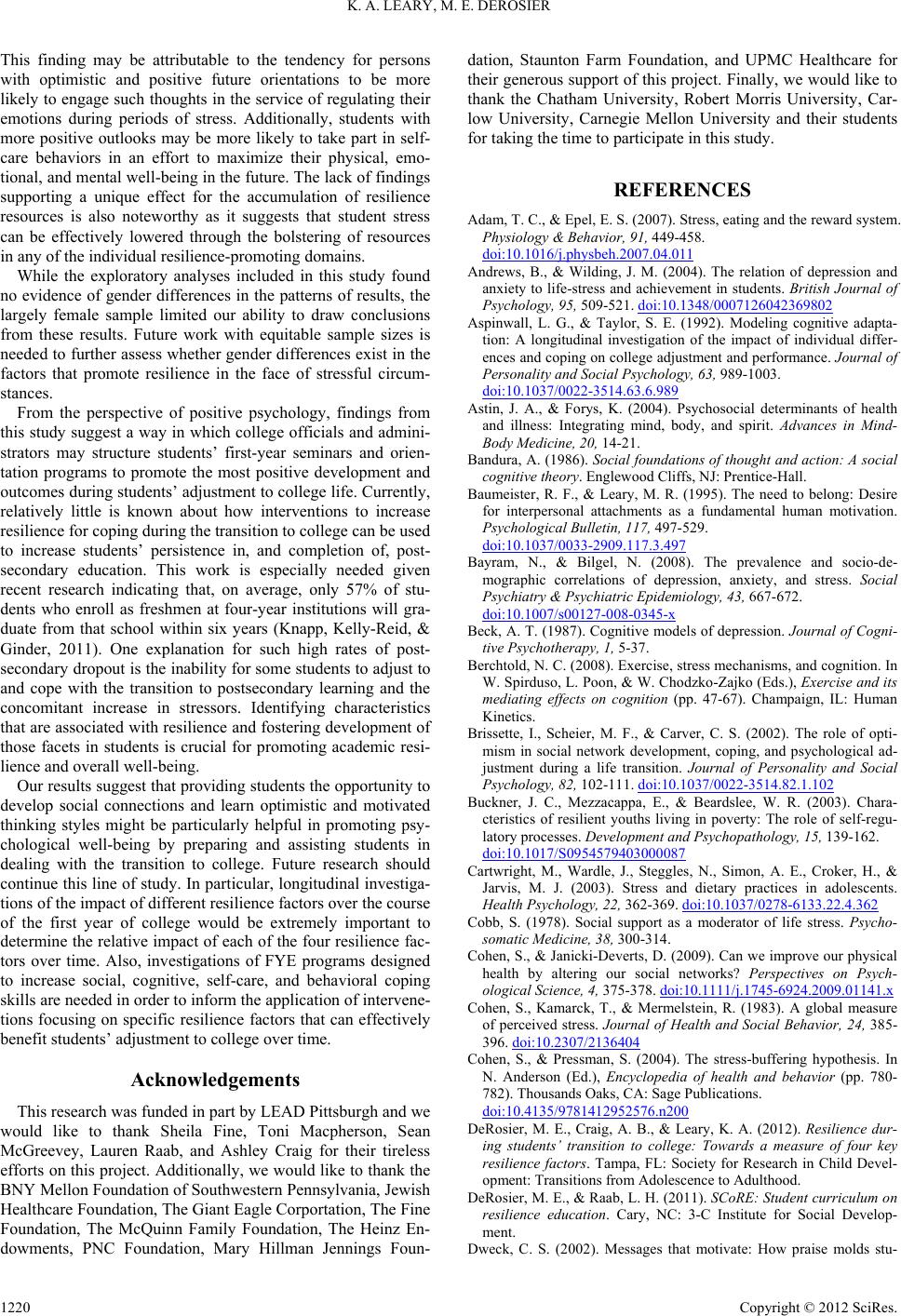 K. A. LEARY, M. E. DEROSIER This finding may be attributable to the tendency for persons with optimistic and positive future orientations to be more likely to engage such thoughts in the service of regulating their emotions during periods of stress. Additionally, students with more positive outlooks may be more likely to take part in self- care behaviors in an effort to maximize their physical, emo- tional, and mental well-being in the future. The lack of findings supporting a unique effect for the accumulation of resilience resources is also noteworthy as it suggests that student stress can be effectively lowered through the bolstering of resources in any of the individual resilience-promoting domains. While the exploratory analyses included in this study found no evidence of gender differences in the patterns of results, the largely female sample limited our ability to draw conclusions from these results. Future work with equitable sample sizes is needed to further assess whether gender differences exist in the factors that promote resilience in the face of stressful circum- stances. From the perspective of positive psychology, findings from this study suggest a way in which college officials and admini- strators may structure students’ first-year seminars and orien- tation programs to promote the most positive development and outcomes during students’ adjustment to college life. Currently, relatively little is known about how interventions to increase resilience for coping during the transition to college can be used to increase students’ persistence in, and completion of, post- secondary education. This work is especially needed given recent research indicating that, on average, only 57% of stu- dents who enroll as freshmen at four-year institutions will gra- duate from that school within six years (Knapp, Kelly-Reid, & Ginder, 2011). One explanation for such high rates of post- secondary dropout is the inability for some students to adjust to and cope with the transition to postsecondary learning and the concomitant increase in stressors. Identifying characteristics that are associated with resilience and fostering development of those facets in students is crucial for promoting academic resi- lience and overall well-being. Our results suggest that providing students the opportunity to develop social connections and learn optimistic and motivated thinking styles might be particularly helpful in promoting psy- chological well-being by preparing and assisting students in dealing with the transition to college. Future research should continue this line of study. In particular, longitudinal investiga- tions of the impact of different resilience factors over the course of the first year of college would be extremely important to determine the relative impact of each of the four resilience fac- tors over time. Also, investigations of FYE programs designed to increase social, cognitive, self-care, and behavioral coping skills are needed in order to inform the application of intervene- tions focusing on specific resilience factors that can effectively benefit students’ adjustment to college over time. Acknowledgements This research was funded in part by LEAD Pittsburgh and we would like to thank Sheila Fine, Toni Macpherson, Sean McGreevey, Lauren Raab, and Ashley Craig for their tireless efforts on this project. Additionally, we would like to thank the BNY Mellon Foundation of Southwestern Pennsylvania, Jewish Healthcare Foundation, The Giant Eagle Corportation, The Fine Foundation, The McQuinn Family Foundation, The Heinz En- dowments, PNC Foundation, Mary Hillman Jennings Foun- dation, Staunton Farm Foundation, and UPMC Healthcare for their generous support of this project. Finally, we would like to thank the Chatham University, Robert Morris University, Car- low University, Carnegie Mellon University and their students for taking the time to participate in this study. REFERENCES Adam, T. C., & Epel, E. S. (2007). Stress, eating and the reward system. Physiology & Behavior, 91, 449-458. doi:10.1016/j.physbeh.2007.04.011 Andrews, B., & Wilding, J. M. (2004). The relation of depression and anxiety to life-stress and achievement in students. British Journal of Psychology, 95, 509-521. doi:10.1348/0007126042369802 Aspinwall, L. G., & Taylor, S. E. (1992). Modeling cognitive adapta- tion: A longitudinal investigation of the impact of individual differ- ences and coping on college adjustment and performance. Journal of Personality and Social P s y chology, 63, 989-1003. doi:10.1037/0022-3514.63.6.989 Astin, J. A., & Forys, K. (2004). Psychosocial determinants of health and illness: Integrating mind, body, and spirit. Advances in Mind- Body Medicine, 20, 14-21. Bandura, A. (1986). Social foundations of thought and action: A social cognitive theory. Englewood Cliffs, NJ: Prentice-Hall. Baumeister, R. F., & Leary, M. R. (1995). The need to belong: Desire for interpersonal attachments as a fundamental human motivation. Psychological Bulletin, 1 1 7, 497-529. doi:10.1037/0033-2909.117.3.497 Bayram, N., & Bilgel, N. (2008). The prevalence and socio-de- mographic correlations of depression, anxiety, and stress. Social Psychiatry & Psychiatric Epidemiology, 43, 667-672. doi:10.1007/s00127-008-0345-x Beck, A. T. (1987). Cognitive models of depression. Journal of Cogni- tive Psychotherapy, 1, 5-37. Berchtold, N. C. (2008). Exercise, stress mechanisms, and cognition. In W. Spirduso, L. Poon, & W. Chodzko-Zajko (Eds.), Exercise and its mediating effects on cognition (pp. 47-67). Champaign, IL: Human Kinetics. Brissette, I., Scheier, M. F., & Carver, C. S. (2002). The role of opti- mism in social network development, coping, and psychological ad- justment during a life transition. Journal of Personality and Social Psychology, 82, 102-111. doi:10.1037/0022-3514.82.1.102 Buckner, J. C., Mezzacappa, E., & Beardslee, W. R. (2003). Chara- cteristics of resilient youths living in poverty: The role of self-regu- latory processes. Development and Psychopathology, 15, 139-162. doi:10.1017/S0954579403000087 Cartwright, M., Wardle, J., Steggles, N., Simon, A. E., Croker, H., & Jarvis, M. J. (2003). Stress and dietary practices in adolescents. Health Psychology, 22, 362-369. doi:10.1037/0278-6133.22.4.362 Cobb, S. (1978). Social support as a moderator of life stress. Psycho- somatic Medicine, 38, 300-314. Cohen, S., & Janicki-Deverts, D. (2009). Can we improve our physical health by altering our social networks? Perspectives on Psych- ological Science, 4, 375-378. doi:10.1111/j.1745-6924.2009.01141.x Cohen, S., Kamarck, T., & Mermelstein, R. (1983). A global measure of perceived stress. Journal of Health and Social Behavior, 24, 385- 396. doi:10.2307/2136404 Cohen, S., & Pressman, S. (2004). The stress-buffering hypothesis. In N. Anderson (Ed.), Encyclopedia of health and behavior (pp. 780- 782). Thousands Oaks, CA: Sage Publications. doi:10.4135/9781412952576.n200 DeRosier, M. E., Craig, A. B., & Leary, K. A. (2012). Resilience dur- ing students’ transition to college: Towards a measure of four key resilience factors. Tampa, FL: Society for Research in Child Devel- opment: Transitions from Adolescence to Adulthood. DeRosier, M. E., & Raab, L. H. (2011). SCoRE: Student curriculum on resilience education. Cary, NC: 3-C Institute for Social Develop- ment. Dweck, C. S. (2002). Messages that motivate: How praise molds stu- Copyright © 2012 SciRes. 1220 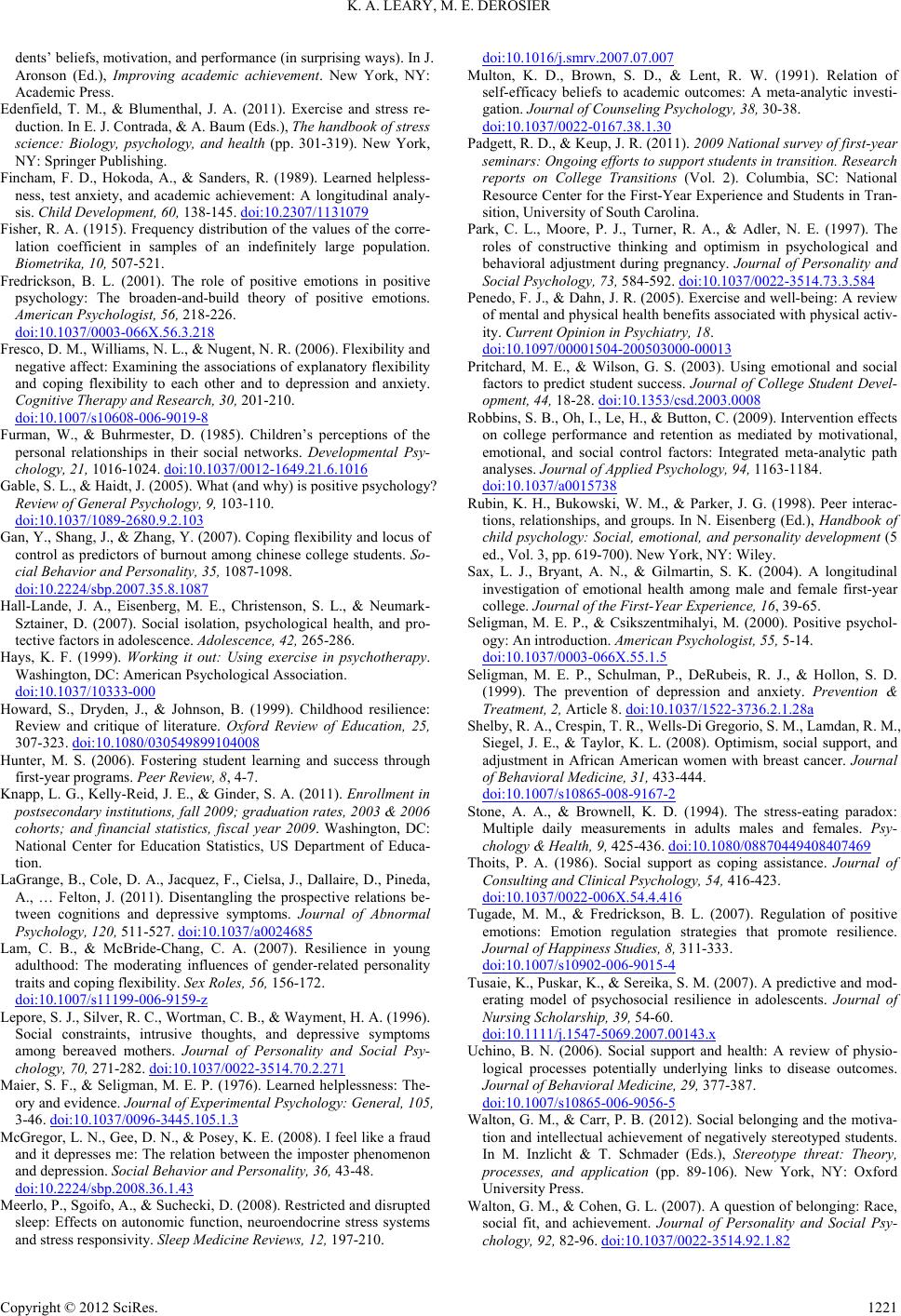 K. A. LEARY, M. E. DEROSIER dents’ beliefs, motivation, and performance (in surprising ways). In J. Aronson (Ed.), Improving academic achievement. New York, NY: Academic Press. Edenfield, T. M., & Blumenthal, J. A. (2011). Exercise and stress re- duction. In E. J. Contrada, & A. Baum (Eds.), The handbook of stress science: Biology, psychology, and health (pp. 301-319). New York, NY: Springer Publishing. Fincham, F. D., Hokoda, A., & Sanders, R. (1989). Learned helpless- ness, test anxiety, and academic achievement: A longitudinal analy- sis. Child Develo pment, 60, 138-145. doi:10.2307/1131079 Fisher, R. A. (1915). Frequency distribution of the values of the corre- lation coefficient in samples of an indefinitely large population. Biometrika, 10, 507-521. Fredrickson, B. L. (2001). The role of positive emotions in positive psychology: The broaden-and-build theory of positive emotions. American Psychologist, 56, 218-226. doi:10.1037/0003-066X.56.3.218 Fresco, D. M., Williams, N. L., & Nugent, N. R. (2006). Flexibility and negative affect: Examining the associations of explanatory flexibility and coping flexibility to each other and to depression and anxiety. Cognitive Therapy and Research, 30, 201-210. doi:10.1007/s10608-006-9019-8 Furman, W., & Buhrmester, D. (1985). Children’s perceptions of the personal relationships in their social networks. Developmental Psy- chology, 21, 1016-1024. doi:10.1037/0012-1649.21.6.1016 Gable, S. L., & Haidt, J. (2005). What (and why) is positive psychology? Review of General Psychology, 9, 103-110. doi:10.1037/1089-2680.9.2.103 Gan, Y., Shang, J., & Zhang, Y. (2007). Coping flexibility and locus of control as predictors of burnout among chinese college students. So- cial Behavior and Personality, 35, 1087-1098. doi:10.2224/sbp.2007.35.8.1087 Hall-Lande, J. A., Eisenberg, M. E., Christenson, S. L., & Neumark- Sztainer, D. (2007). Social isolation, psychological health, and pro- tective factors in adolescence. Adolescence, 42, 265-286. Hays, K. F. (1999). Working it out: Using exercise in psychotherapy. Washington, DC: American Psychological Association. doi:10.1037/10333-000 Howard, S., Dryden, J., & Johnson, B. (1999). Childhood resilience: Review and critique of literature. Oxford Review of Education, 25, 307-323. doi:10.1080/030549899104008 Hunter, M. S. (2006). Fostering student learning and success through first-year programs. Peer Review, 8, 4-7. Knapp, L. G., Kelly-Reid, J. E., & Ginder, S. A. (2011). Enrollment in postsecondary institutions, fall 2009; graduation rates, 2003 & 2006 cohorts; and financial statistics, fiscal year 2009. Washington, DC: National Center for Education Statistics, US Department of Educa- tion. LaGrange, B., Cole, D. A., Jacquez, F., Cielsa, J., Dallaire, D., Pineda, A., … Felton, J. (2011). Disentangling the prospective relations be- tween cognitions and depressive symptoms. Journal of Abnormal Psychology, 120, 511-527. doi:10.1037/a0024685 Lam, C. B., & McBride-Chang, C. A. (2007). Resilience in young adulthood: The moderating influences of gender-related personality traits and coping flexibility. Sex Roles, 56, 156-172. doi:10.1007/s11199-006-9159-z Lepore, S. J., Silver, R. C., Wortman, C. B., & Wayment, H. A. (1996). Social constraints, intrusive thoughts, and depressive symptoms among bereaved mothers. Journal of Personality and Social Psy- chology, 70, 271-282. doi:10.1037/0022-3514.70.2.271 Maier, S. F., & Seligman, M. E. P. (1976). Learned helplessness: The- ory and evidence. Journal of Experimental Psychology: General, 105, 3-46. doi:10.1037/0096-3445.105.1.3 McGregor, L. N., Gee, D. N., & Posey, K. E. (2008). I feel like a fraud and it depresses me: The relation between the imposter phenomenon and depression. Social Be h a v i o r a nd Personality, 36, 43-48. doi:10.2224/sbp.2008.36.1.43 Meerlo, P., Sgoifo, A., & Suchecki, D. (2008). Restricted and disrupted sleep: Effects on autonomic function, neuroendocrine stress systems and stress responsivity. Sleep Medicine Reviews, 12, 197-210. doi:10.1016/j.smrv.2007.07.007 Multon, K. D., Brown, S. D., & Lent, R. W. (1991). Relation of self-efficacy beliefs to academic outcomes: A meta-analytic investi- gation. Journal of Counseling Psychology, 38, 30-38. doi:10.1037/0022-0167.38.1.30 Padgett, R. D., & Keup, J. R. (2011). 2009 National survey of first-year seminars: Ongoing efforts to support students in transition. Research reports on College Transitions (Vol. 2). Columbia, SC: National Resource Center for the First-Year Experience and Students in Tran- sition, University of South Carolina. Park, C. L., Moore, P. J., Turner, R. A., & Adler, N. E. (1997). The roles of constructive thinking and optimism in psychological and behavioral adjustment during pregnancy. Journal of Personality and Social Psychology, 73, 584-592. doi:10.1037/0022-3514.73.3.584 Penedo, F. J., & Dahn, J. R. (2005). Exercise and well-being: A review of mental and physical health benefits associated with physical activ- ity. Current Opinion in Psychiatry, 18. doi:10.1097/00001504-200503000-00013 Pritchard, M. E., & Wilson, G. S. (2003). Using emotional and social factors to predict student success. Journal of College Student Devel- opment, 44, 18-28. doi:10.1353/csd.2003.0008 Robbins, S. B., Oh, I., Le, H., & Button, C. (2009). Intervention effects on college performance and retention as mediated by motivational, emotional, and social control factors: Integrated meta-analytic path analyses. Journal of Applied Psychology, 94, 1163-1184. doi:10.1037/a0015738 Rubin, K. H., Bukowski, W. M., & Parker, J. G. (1998). Peer interac- tions, relationships, and groups. In N. Eisenberg (Ed.), Handbook of child psychology: Social, emotional, and personality development (5 ed., Vol. 3, pp. 619-700). New York, NY: Wiley. Sax, L. J., Bryant, A. N., & Gilmartin, S. K. (2004). A longitudinal investigation of emotional health among male and female first-year college. Journal of the First-Year Experience, 16, 39-65. Seligman, M. E. P., & Csikszentmihalyi, M. (2000). Positive psychol- ogy: An introduction. American Psychologist, 55, 5-14. doi:10.1037/0003-066X.55.1.5 Seligman, M. E. P., Schulman, P., DeRubeis, R. J., & Hollon, S. D. (1999). The prevention of depression and anxiety. Prevention & Treatment, 2, Article 8. doi:10.1037/1522-3736.2.1.28a Shelby, R. A., Crespin, T. R., Wells-Di Gregorio, S. M., Lamdan, R. M., Siegel, J. E., & Taylor, K. L. (2008). Optimism, social support, and adjustment in African American women with breast cancer. Journal of Behavioral Medicine, 31, 433-444. doi:10.1007/s10865-008-9167-2 Stone, A. A., & Brownell, K. D. (1994). The stress-eating paradox: Multiple daily measurements in adults males and females. Psy- chology & Health, 9, 425-436. doi:10.1080/08870449408407469 Thoits, P. A. (1986). Social support as coping assistance. Journal of Consulting and Clinic a l P s yc h o l o g y , 54 , 416-423. doi:10.1037/0022-006X.54.4.416 Tugade, M. M., & Fredrickson, B. L. (2007). Regulation of positive emotions: Emotion regulation strategies that promote resilience. Journal of Happiness Studies, 8, 311-333. doi:10.1007/s10902-006-9015-4 Tusaie, K., Puskar, K., & Sereika, S. M. (2007). A predictive and mod- erating model of psychosocial resilience in adolescents. Journal of Nursing Scholarship, 39, 54-60. doi:10.1111/j.1547-5069.2007.00143.x Uchino, B. N. (2006). Social support and health: A review of physio- logical processes potentially underlying links to disease outcomes. Journal of Behavioral Medici ne , 29, 377-387. doi:10.1007/s10865-006-9056-5 Walton, G. M., & Carr, P. B. (2012). Social belonging and the motiva- tion and intellectual achievement of negatively stereotyped students. In M. Inzlicht & T. Schmader (Eds.), Stereotype threat: Theory, processes, and application (pp. 89-106). New York, NY: Oxford University Press. Walton, G. M., & Cohen, G. L. (2007). A question of belonging: Race, social fit, and achievement. Journal of Personality and Social Psy- chology, 92, 82-96. doi:10.1037/0022-3514.92.1.82 Copyright © 2012 SciRes. 1221 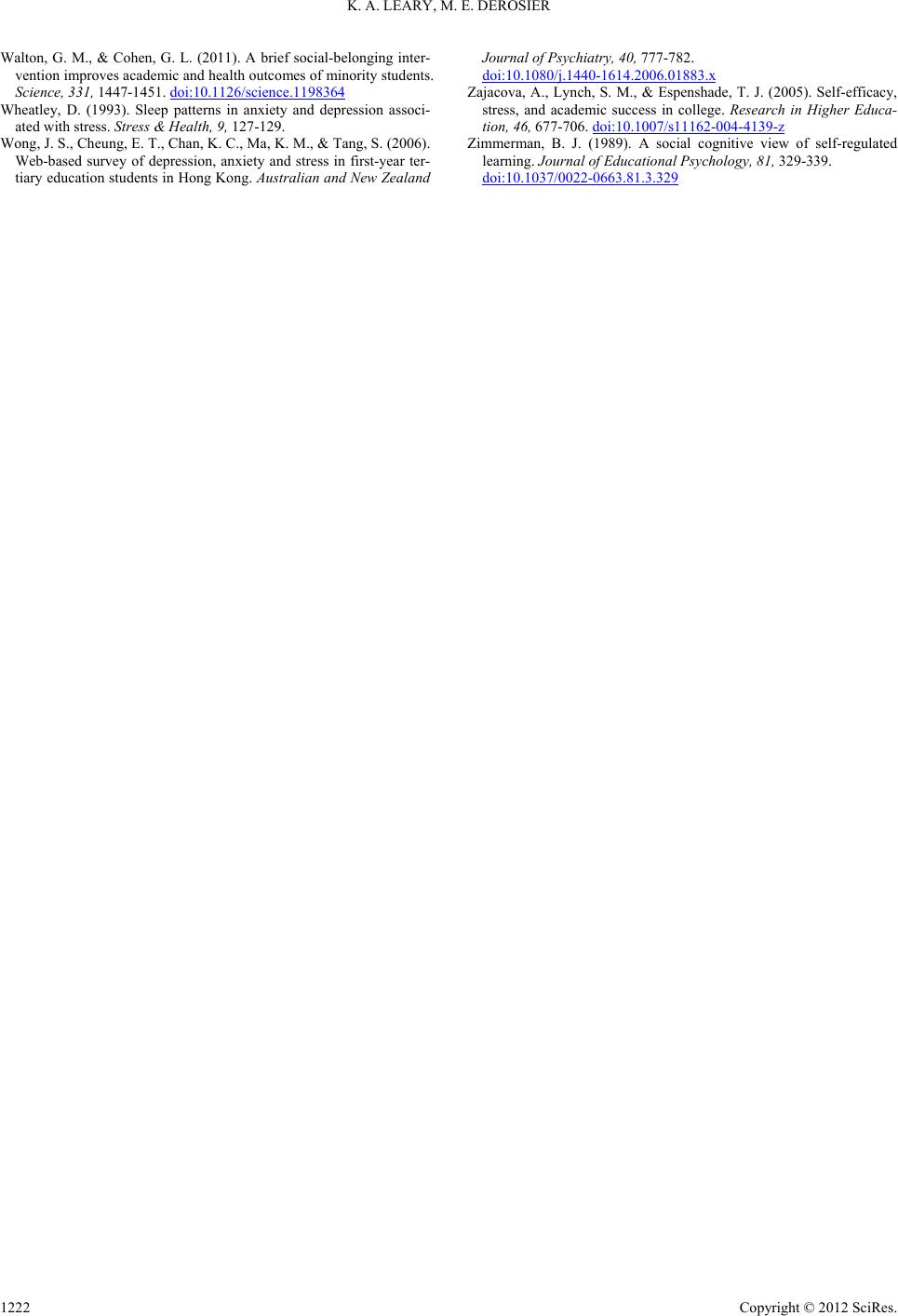 K. A. LEARY, M. E. DEROSIER Copyright © 2012 SciRes. 1222 Walton, G. M., & Cohen, G. L. (2011). A brief social-belonging inter- vention improves academic and health outcomes of minority students. Science, 331, 1447-1451. doi:10.1126/science.1198364 Wheatley, D. (1993). Sleep patterns in anxiety and depression associ- ated with stress. Stress & Health, 9, 127-129. Wong, J. S., Cheung, E. T., Chan, K. C., Ma, K. M., & Tang, S. (2006). Web-based survey of depression, anxiety and stress in first-year ter- tiary education students in Hong Kong. Australian and New Zealand Journal of Psychiatry, 40, 777-782. doi:10.1080/j.1440-1614.2006.01883.x Zajacova, A., Lynch, S. M., & Espenshade, T. J. (2005). Self-efficacy, stress, and academic success in college. Research in Higher Educa- tion, 46, 677-706. doi:10.1007/s11162-004-4139-z Zimmerman, B. J. (1989). A social cognitive view of self-regulated learning. Journal of Educational Psychology, 81, 329-339. doi:10.1037/0022-0663.81.3.329
|